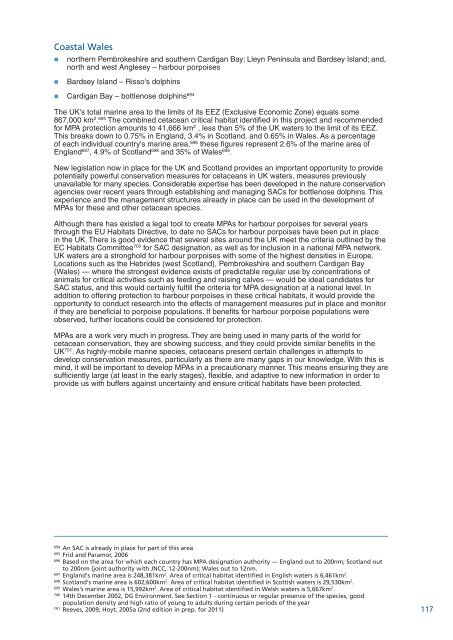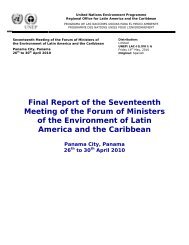10. CONCLUSIONSThis project identified a number of areas of cetacean critical habitat in UK waters, sites usedregularly for critical life processes such as feeding and raising young. Critical habitat was identifiedfor harbour porpoises, bottlenose dolphins, white-beaked dolphins, Risso's dolphins, minke whales,and short-beaked common dolphins. For at least harbour porpoises, white-beaked dolphins, minkewhales and common dolphins, given the importance of UK waters for these species, it is highlylikely that further areas of critical habitat exist.Insufficient data were available to allow the identification of critical habitat for other species. Formany – particularly Atlantic white-sided dolphins, long-finned pilot whales, northern bottlenosewhales, Sowerby's beaked whales, sperm whales and killer whales – the UK's waters providesignificant areas of habitat and, within this, there will be areas of critical habitat, important for criticallife processes such as breeding, calving and feeding. Several areas of interest were identified forthese species, showing some evidence of importance, and these should be investigated further.It is important to stress that information is often patchy and in some areas severely lacking. In anideal world, assessments such as these would be undertaken using datasets that when combinedprovide complete and even coverage throughout the survey area. This level of information will notbe available for many years, if ever, and decisions must be taken in the meantime using the datathat are available. The results from this project will invariably be biased towards areas where wehave information. Areas not identified as 'critical habitat' or 'areas of interest' are notnecessarily unimportant, there may just be little or no information available at presentwith which to make an assessment.To take this work further, the key next steps would be to incorporate a review of cetacean preydata and to give greater consideration to predator/prey dynamics as these will be important factorsin refining as well as identifying additional locations of cetacean critical habitat. Also, overlayingcetacean data with data for other mobile marine species, such as basking sharks, seabirds, seals,may reveal ‘hot spots’ that are important to a number of species. In other areas of the world, notablythe Mediterranean, this approach has revealed significant overlap and could be useful in selectingareas that achieve protection for multiple species 691 .The areas of critical habitat identified through this project meet the guidelines for establishing MPAsin UK waters 692 . Following a consideration of threats present in these areas, we recommend thatfour areas should be considered for MPA protection, or have existing protection extended:The Hebrides the Inner Hebrides, The Minches and the Sea of the Hebrides – harbour porpoisenorth east Isle of Lewis – Risso's dolphinsthe Inner Hebrides and the Sound of Barra – bottlenose dolphinsOther species present here that could also benefit from protective measures put in place arecommon dolphins, white-beaked dolphins, minke whales and killer whales.North east Scotland south coast, Outer Moray Firth – harbour porpoise Inner Moray Firth and north east Scottish coast to St. Andrew's Bay – bottlenose dolphins 693south coast, Outer Moray Firth – minke whalesAberdeenshire coast – white-beaked dolphinsSouth west England Celtic Deep – common dolphinsOther species that may benefit from an MPA in this area include minke whales.116691Hoyt, in Reeves, 2009692See Section 2693An SAC is already in place for part of this area
Coastal Wales northern Pembrokeshire and southern Cardigan Bay; Lleyn Peninsula and Bardsey Island; and,north and west Anglesey – harbour porpoisesBardsey Island – Risso's dolphins Cardigan Bay – bottlenose dolphins 694The UK's total marine area to the limits of its EEZ (Exclusive Economic Zone) equals some867,000 km 2 . 695 The combined cetacean critical habitat identified in this project and recommendedfor MPA protection amounts to 41,666 km 2 , less than 5% of the UK waters to the limit of its EEZ.This breaks down to 0.75% in England, 3.4% in Scotland, and 0.65% in Wales. As a percentageof each individual country's marine area, 696 these figures represent 2.6% of the marine area ofEngland 697 , 4.9% of Scotland 698 and 35% of Wales 699 .New legislation now in place for the UK and Scotland provides an important opportunity to providepotentially powerful conservation measures for cetaceans in UK waters, measures previouslyunavailable for many species. Considerable expertise has been developed in the nature conservationagencies over recent years through establishing and managing SACs for bottlenose dolphins. Thisexperience and the management structures already in place can be used in the development ofMPAs for these and other cetacean species.Although there has existed a legal tool to create MPAs for harbour porpoises for several yearsthrough the EU Habitats Directive, to date no SACs for harbour porpoises have been put in placein the UK. There is good evidence that several sites around the UK meet the criteria outlined by theEC Habitats Committee 700 for SAC designation, as well as for inclusion in a national MPA network.UK waters are a stronghold for harbour porpoises with some of the highest densities in Europe.Locations such as the Hebrides (west Scotland), Pembrokeshire and southern Cardigan Bay(Wales) — where the strongest evidence exists of predictable regular use by concentrations ofanimals for critical activities such as feeding and raising calves — would be ideal candidates forSAC status, and this would certainly fulfill the criteria for MPA designation at a national level. Inaddition to offering protection to harbour porpoises in these critical habitats, it would provide theopportunity to conduct research into the effects of management measures put in place and monitorif they are beneficial to porpoise populations. If benefits for harbour porpoise populations wereobserved, further locations could be considered for protection.MPAs are a work very much in progress. They are being used in many parts of the world forcetacean conservation, they are showing success, and they could provide similar benefits in theUK 701 . As highly-mobile marine species, cetaceans present certain challenges in attempts todevelop conservation measures, particularly as there are many gaps in our knowledge. With this ismind, it will be important to develop MPAs in a precautionary manner. This means ensuring they aresufficiently large (at least in the early stages), flexible, and adaptive to new information in order toprovide us with buffers against uncertainty and ensure critical habitats have been protected.694An SAC is already in place for part of this area695Frid and Paramor, 2006696Based on the area for which each country has MPA designation authority — England out to 200nm; Scotland outto 200nm (joint authority with JNCC, 12200nm); Wales out to 12nm.697England's marine area is 248,381km 2 . Area of critical habitat identified in <strong>English</strong> waters is 6,461km 2 .698Scotland's marine area is 602,600km 2 . Area of critical habitat identified in Scottish waters is 29,530km 2 .699Wales's marine area is 15,992km 2 . Area of critical habitat identified in Welsh waters is 5,667km 2 .70014th December 2002, DG <strong>Environment</strong>. See Section 1 continuous or regular presence of the species, goodpopulation density and high ratio of young to adults during certain periods of the year701Reeves, 2009; Hoyt, 2005a (2nd edition in prep. for 2011)117
- Page 1 and 2:
WDCS, the Whale and Dolphin Conserv
- Page 3 and 4:
Towards Marine ProtectedAreas for C
- Page 5 and 6:
South west EnglandCeltic Deep - com
- Page 7 and 8:
CONTENTSExecutive Summary 2Acknowle
- Page 9 and 10:
1. INTRODUCTIONWe enter an exciting
- Page 11 and 12:
Note: This schematic map shows thev
- Page 13 and 14:
2. IDENTIFYING MARINE PROTECTED ARE
- Page 15 and 16:
3. CRITICAL HABITATInterest in the
- Page 17 and 18:
Foraging, travel, socialising and p
- Page 19 and 20:
4. DATA AND SPECIES ACCOUNTSIn orde
- Page 21 and 22:
Killer whale (Orcinus orca)Atlantic
- Page 23 and 24:
4.4 SPECIES ACCOUNTS4.4.1 HARBOUR P
- Page 25 and 26:
Although there is some variation in
- Page 27 and 28:
North ScotlandThe first SCANS surve
- Page 29 and 30:
East EnglandThe seasonal pattern in
- Page 31 and 32:
Irish SeaOutside of coastal Welsh w
- Page 33 and 34:
4.4.2 BOTTLENOSE DOLPHIN (Tursiops
- Page 35 and 36:
This expansion in range means this
- Page 37 and 38:
4.4.3 SHORTBEAKED COMMON DOLPHIN (D
- Page 39 and 40:
South west EnglandBased on observat
- Page 41 and 42:
4.4.4 COMMON MINKE WHALE (Balaenopt
- Page 43 and 44:
Sightings for this area of the Oute
- Page 45 and 46:
The JNCC Atlas of cetacean distribu
- Page 47 and 48:
4.4.5 WHITEBEAKED DOLPHIN (Lagenorh
- Page 49 and 50:
4.4.6 RISSO'S DOLPHIN (Grampus gris
- Page 51 and 52:
4.4.7 KILLER WHALE OR ORCA (Orcinus
- Page 53 and 54:
4.4.8 ATLANTIC WHITESIDED DOLPHIN (
- Page 55 and 56:
4.4.9 LONGFINNED PILOT WHALE (Globi
- Page 57 and 58:
4.4.10 SPERM WHALE (Physeter macroc
- Page 59 and 60:
4.4.11 BEAKED WHALESNORTHERN BOTTLE
- Page 61 and 62:
which looked at worldwide beaked wh
- Page 63 and 64:
There is no current population esti
- Page 65 and 66:
4.5 SCOTTISH MPA GUIDELINES - STAGE
- Page 67 and 68: Northern bottlenose whale and Sower
- Page 69 and 70: Fisheries BycatchFisheries bycatch
- Page 71 and 72: 5.2 AN OVERVIEW OF REGIONAL THREATS
- Page 73 and 74: North ScotlandAs in the west, threa
- Page 75 and 76: 6. IDENTIFYING CRITICAL HABITAT IN
- Page 77 and 78: 6.1.1 HARBOUR PORPOISEWest and sout
- Page 79 and 80: Assessment: Critical HabitatHigh re
- Page 81 and 82: 11. Area: Off Land's End, Cornwall
- Page 83 and 84: Threats, status and relative import
- Page 85 and 86: East Scotland3. Area: North east Sc
- Page 87 and 88: Threats, status and relative import
- Page 89 and 90: 6.1.4 COMMON MINKE WHALEWest and so
- Page 91 and 92: 6.1.5 WHITEBEAKED DOLPHINWest and s
- Page 93 and 94: Coastal Wales2. Area: Bardsey Islan
- Page 95 and 96: 6.1.8 ATLANTIC WHITESIDED DOLPHINNo
- Page 97 and 98: Other areasOne other area was asses
- Page 99 and 100: 6.1.11 BEAKED WHALESThe northern Ro
- Page 101 and 102: 7. PROTECTING CRITICAL HABITAT - RE
- Page 103 and 104: considered in the area, each of whi
- Page 105 and 106: 7.4 EAST SCOTLANDWithin the east Sc
- Page 107 and 108: 7.5 SOUTH WEST ENGLANDWithin the so
- Page 109 and 110: An SAC is already in place for bott
- Page 111 and 112: 7.9 SUMMARYFour areas of identified
- Page 113 and 114: iv. Licensing processes for industr
- Page 115 and 116: 9. IDENTIFICATION AND PRIORITISATIO
- Page 117: Recommendations on particular data
- Page 121 and 122: ANNEX II SPECIES ACCOUNTS SUMMARY
- Page 123 and 124: HARBOUR PORPOISEEast ScotlandStudyH
- Page 125 and 126: HARBOUR PORPOISESouth West EnglandS
- Page 127 and 128: HARBOUR PORPOISECoastal WalesStudyT
- Page 129 and 130: BOTTLENOSE DOLPHINStudyTemporalReso
- Page 131 and 132: SHORTBEAKED COMMON DOLPHINStudyTemp
- Page 133 and 134: SHORTBEAKED COMMON DOLPHINStudyTemp
- Page 135 and 136: COMMON MINKE WHALEWest ScotlandStud
- Page 137 and 138: WHITEBEAKED DOLPHINStudyTemporalRes
- Page 139 and 140: KILLER WHALEStudyTemporalResolution
- Page 141 and 142: ATLANTIC WHITESIDED DOLPHINStudyTem
- Page 143 and 144: SPERM WHALEStudyTemporalResolutionS
- Page 145 and 146: BALEEN WHALESStudyTemporalResolutio
- Page 147 and 148: ANNEX III THREATS TO CETACEANS - RE
- Page 149 and 150: Actual orPotential ThreatActivitySp
- Page 151: North ScotlandSpecies of most relev
- Page 156 and 157: East EnglandSpecies of most relevan
- Page 158 and 159: South East EnglandSpecies of most r
- Page 160 and 161: South West EnglandSpecies of most r
- Page 162 and 163: Irish SeaSpecies of most relevance
- Page 164 and 165: Actual orPotential ThreatActivitySp
- Page 166 and 167: Bravington, M., Borchers, D. and No
- Page 168 and 169:
Evans, P.G.H. and Anderwald, P. 200
- Page 170 and 171:
ICES WGMME. 2006. Report of the Wor
- Page 172 and 173:
ECS/ASCOBANS/ACCOBAMS Workshop held
- Page 174 and 175:
marine protected areas effective to
- Page 176:
ISBN: 9781901386233
















